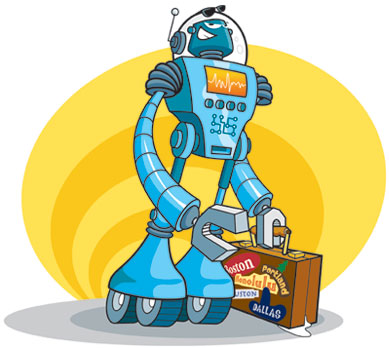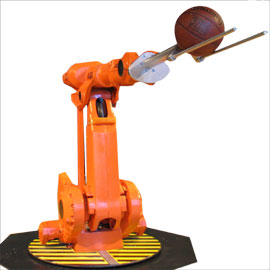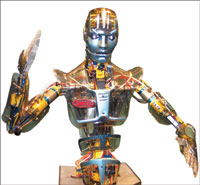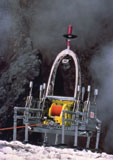After
five great years on the road… It’s
Back!

The
Return of
By Ellen S. Wilson

Illustration
Ted Frymark
Robotics enjoyed a successful, although brief, one-year
stay in Pittsburgh. But since it was created to be
a traveling exhibit, off it went—to Tampa, Boston,
Dallas, Houston, Portland, San Jose, Honolulu, Vancouver,
Edmonton, and a host of other cities.
“
It's been a blockbuster everywhere it’s gone,” says
Tom Flaherty, the Science Center’s director
of Exhibits and Facilities. “It’s been
on the road for nearly six years and has exceeded
our
expectations.” Now Robotics is heading back
to Carnegie Science Center for another one-year stint.
The
seed for the 6,000-square-foot interactive Robotics
exhibit was germinated in 1995 when the Science
Center began to create high-tech exhibitions relevant
to
the technology growth of the region. The goal was
to produce
exhibits that showcased Pittsburgh’s leadership
in Robotics and medicine. The result was Robotics
and ZAP!: Surgery Beyond the Cutting Edge.
 The creation
of Robotics was a massive enterprise, taking
over two years to design and build. “No
one had ever successfully created a traveling
exhibition on Robotics,” Flaherty says of the
endeavor. And its pedigree is distinguished: Local
Robotics
businesses including Universal Technology Inc.,
American Robot
Inc., and Carnegie Mellon University's Robotics
Institute, as well as leading robot manufacturers
from around
the country collaborated on its creation. The creation
of Robotics was a massive enterprise, taking
over two years to design and build. “No
one had ever successfully created a traveling
exhibition on Robotics,” Flaherty says of the
endeavor. And its pedigree is distinguished: Local
Robotics
businesses including Universal Technology Inc.,
American Robot
Inc., and Carnegie Mellon University's Robotics
Institute, as well as leading robot manufacturers
from around
the country collaborated on its creation.
The ABB arm is a robot that visitors can program to
shoot hoops. But
the Science Center staff was sure the work was worth
the effort, and the exhibit would be
a crowd-pleaser. “Robot-related
displays had been drawing crowds back to the
days of the Buhl Planetarium,” says Flaherty.
The
fascination with robots obviously extended
beyond western Pennsylvania. During its travels,
Robotics
enjoyed record attendance. Flaherty estimates
that approximately 2.8 million people have
played with
and learned from Robotics since its premiere.
He
assures us that when Robotics returns to Pittsburgh,
it will be none the worse for the wear. "
Our goal is to keep the exhibit working 100 percent
of the time,” says Flaherty. “Robotics
has been well maintained since it was created.” In
fact, wherever the exhibit went, it was accompanied
by two Carnegie Science Center employees who trained
staff at Robotics’ temporary home to keep the
exhibit running smoothly. Extensive maintenance manuals
with troubleshooting procedures for every component
were left behind as well.
For those who missed the exhibit the first
time—or
those who long for another chance to best a
machine—Robotics
reopens at Carnegie Science Center October
11.

Sarcos,
an animatron
(a programmed machine),
greets visitors
and explains
what the exhibit is about.
Robots: a Growing Population
The primary goal of Robotics is to address
the increasing level of Robotics technology
in all
areas of life
as well as the growing career and business
opportunities in the Robotics field.
Ninety percent of all
robots used today are found in factories, but
they are
finding their way into warehouses, laboratories,
research
sites,
energy plants, hospitals, and outer space.
Robots make jobs easier for people because
they can
go where humans
can’t (through the Titanic for instance),
where humans don’t want to go (into a
sewer to check for cracks and obstructions),
and tackle dangerous
tasks (handling hazardous waste). They also
perform tasks that make a human feel like an
android—such
as endlessly screwing lids on ketchup bottles.
Then again, even though robots can range from
simple machines to highly complex, computer-controlled
devices, they can’t create or think independently,
learn from mistakes, adapt to changes in their
surroundings,
or do several vastly different tasks at the
same time. There’s no such thing as multitasking
in a robot’s
vocabulary. With that in mind, there’s
little chance that robots will take over the
workplace, let
alone the world, as many science fiction novels
and movies forecast.
But that doesn’t
mean there aren’t similarities
between robots and humans—as Robotics demonstrates.
In many ways robots and people have a lot in
common: both gather information about their
environment (sense)
and use that information (think) to follow
instructions to complete a task (act). It’s
just that robots and humans go about these
functions differently. People
use sight, sound, smell, taste, and touch to
observe the world around them—a robot,
however, is pretty much deaf and blind. Even
though some robots can “sense” things
people can’t, including movement too
small or fast for the human eye to detect or
tiny amounts of
invisible radiation, robots provide very limited
feedback.
And that’s what Robotics is
all about—seeing
what robots are (and aren’t); comparing
the differences between how humans and robots
operate; learning how
a robot works; and exploring how robots will
change the future.
 Robotics, which includes more than
30 different hands-on activities, will appeal
to people
of all ages. There’s
even a Kids Zone area where young children
can build and program robots and use mechanical
arms to manipulate
objects. There are famous robots, as well.
No, not Robocop, but Dante II, which completed
a remote mission
inside the live volcano Mt. Spur, and Terregator,
the world's first autonomous mobile robot.
A video on the
display floor provides scenes of Dante II in
action. Both Dante II and Terregator are on
loan from Carnegie
Mellon University. Robotics, which includes more than
30 different hands-on activities, will appeal
to people
of all ages. There’s
even a Kids Zone area where young children
can build and program robots and use mechanical
arms to manipulate
objects. There are famous robots, as well.
No, not Robocop, but Dante II, which completed
a remote mission
inside the live volcano Mt. Spur, and Terregator,
the world's first autonomous mobile robot.
A video on the
display floor provides scenes of Dante II in
action. Both Dante II and Terregator are on
loan from Carnegie
Mellon University.
Dante II decends
into a live
volcano.
If visitors are looking for
the type of robots portrayed in movies—such
as A.I. and Blade Runner—well,
they’ll have to visit the sci-fi shelf
at the video store. The closest thing to a
movie robot at
Robotics is the humanoid Sarcos Animatronic
that greets visitors and humorously dispels
some misconceptions
about present-day robots. In fact, Robotics proves
Hollywood robots are a far cry from reality’s
robots.
The real robots at the Science Center
are both fun and user-friendly. Visitors
can program
a seven-foot-tall ABB Basketball Robot to
shoot basketballs with
95
percent accuracy (ABB robots are used to
assemble cars in factories)
and interact with DynaVox, a speech synthesizer
robot designed to help people with physical
challenges.
Trying To Beat the Machine
Probably the best part of Robotics is
trying to beat the machines. Can you fool an ultrasonic
motion
detector
system? How about beating a high-speed assembly line
robot at sorting and identifying 12 keys to unlock
3 locks? Not to ruin the fun, but the robot usually
performs the key sorting task in 24 seconds (at least
30 percent faster than a human). Maybe that’s
why Pepperidge Farms uses a similar one to sort cookies
in its factory?
 There are some tasks, however, that
humans still perform better than robots. At “Tie
Your Shoes,” visitors
can try the sensory deprivation exercise of tying a
shoe while blindfolded and using two pairs of Robogrip
pliers instead of their hands. Robots can’t do
it either. In fact, Robotics proves robots
can’t
do many simple human tasks. In the world of man vs.
machine, there is definitely a trade-off. There are some tasks, however, that
humans still perform better than robots. At “Tie
Your Shoes,” visitors
can try the sensory deprivation exercise of tying a
shoe while blindfolded and using two pairs of Robogrip
pliers instead of their hands. Robots can’t do
it either. In fact, Robotics proves robots
can’t
do many simple human tasks. In the world of man vs.
machine, there is definitely a trade-off.
Since being created eight years ago, there have been
some radical advances in the Robotics field
and the Science Center staff have kept up with new
technology. “We've
upgraded several components—such as the Robot
or Rembrandt Drawing Arm, The Mobot Mobile Robot, and
ABB Basketball Robot—along with some computer
equipment,” says Flaherty. “All these components
still represent fairly new technologies, most of which
have not been seen by the average person.” Flaherty
adds that he and his staff are working with Carnegie
Mellon in hopes of adding at least one new element
to the exhibition during its run in Pittsburgh.
And then, on September 7, 2004, Robotics will
be packed up once again for another cross-country
tour.
Back to Contents |